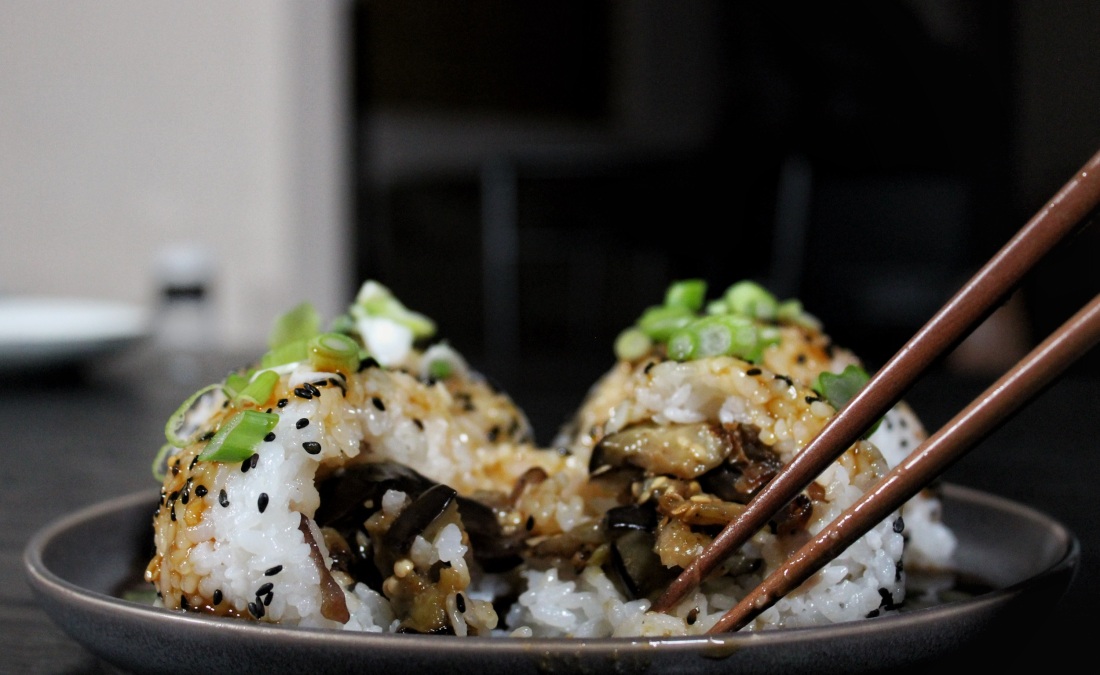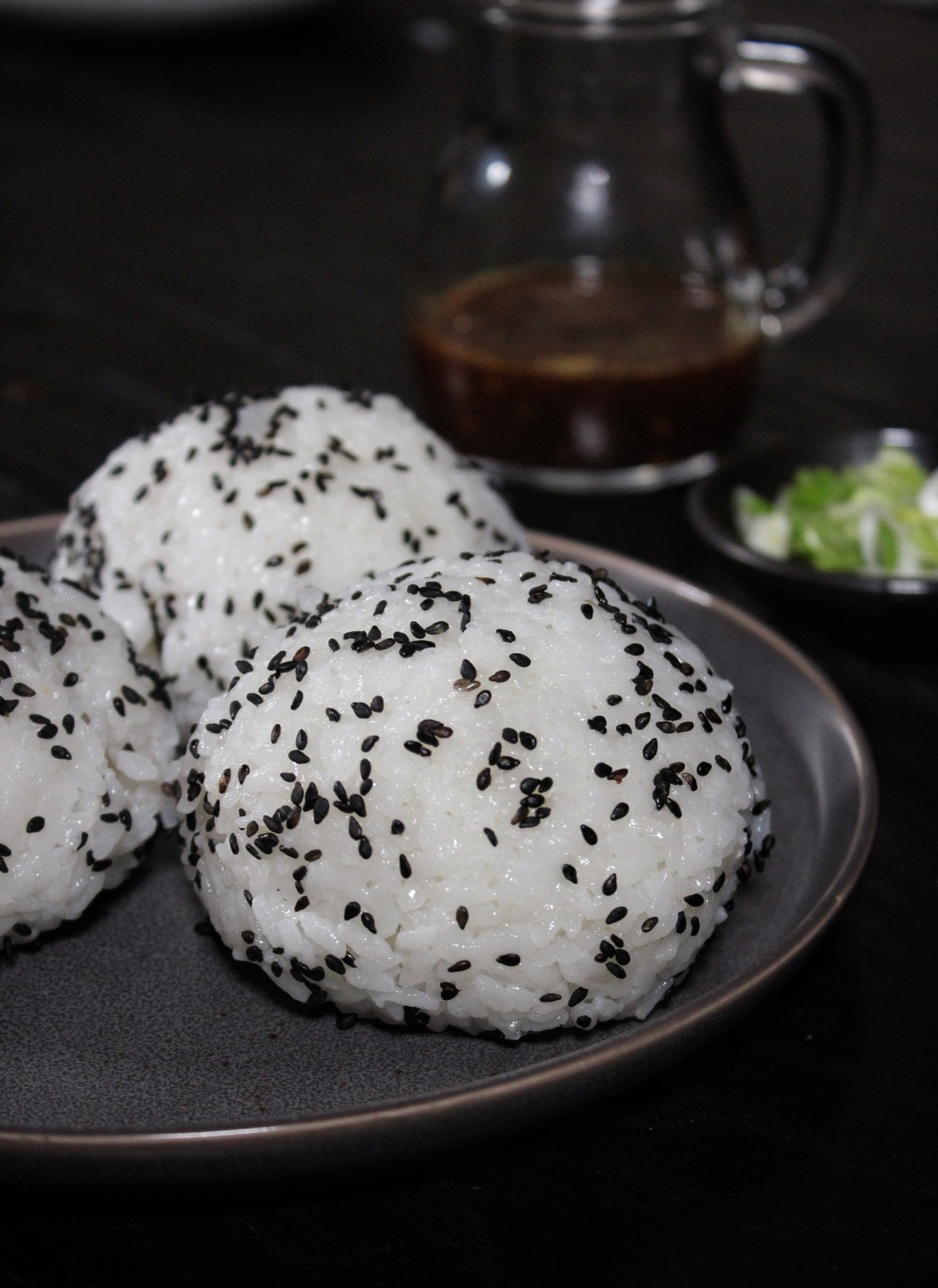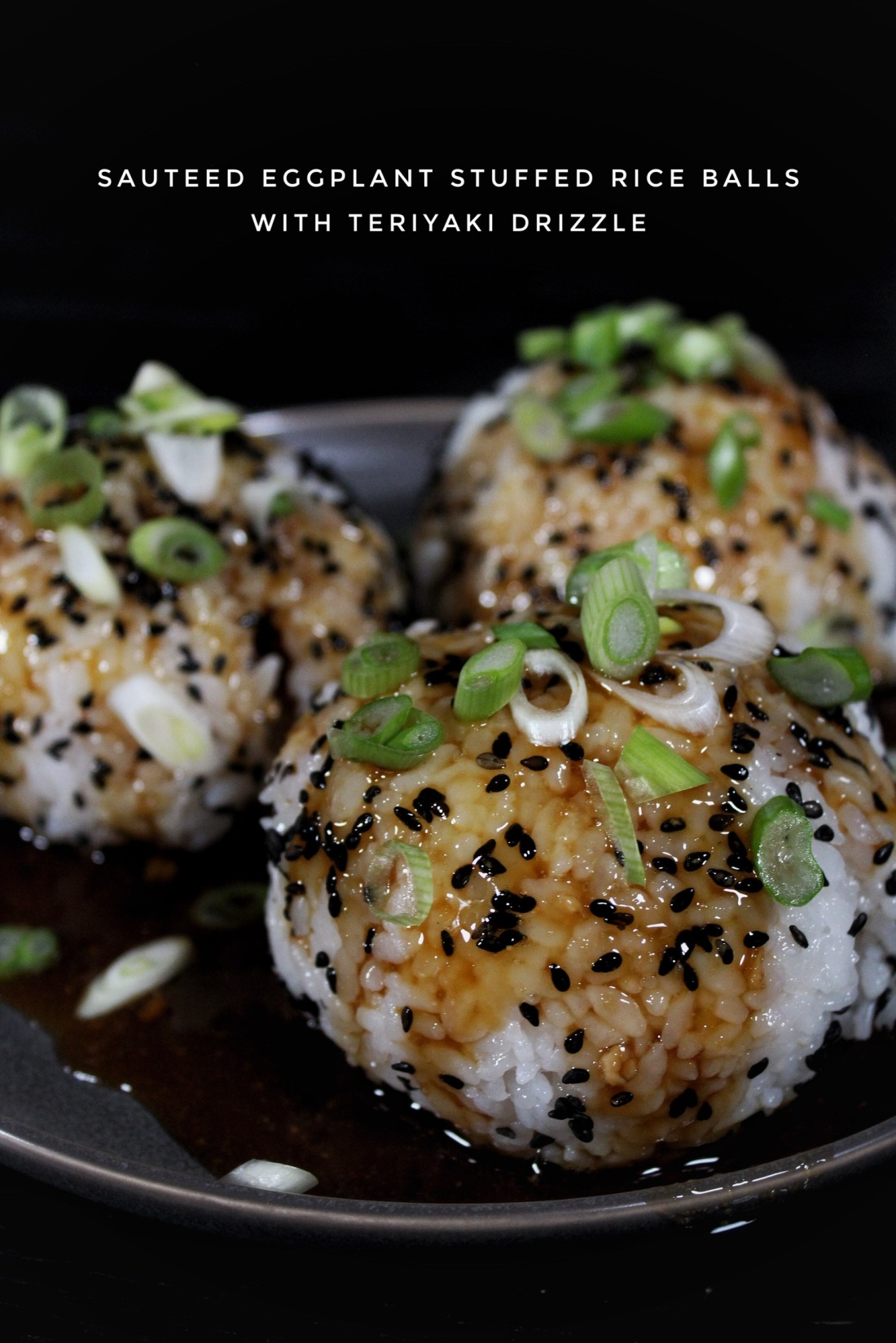Rice Balls! A.k.a. the most fun you can have at a dinner table.
Never had one before? Neither had we (up until making these), but they seemed to be a bright idea – imagine a sushi roll or poke bowl, but wrapped up into an edible, handheld ball.
On the outside is sushi rice, which… you know, is the rice that you buy from the sushi store meant just for sushi… okay, maybe I’m blowing smoke out my behind. What sushi rice really is is short grain, Japanese rice that’s rinsed, soaked, cooked, and mixed with rice vinegar, salt, and sugar. Each part of the process is important to coming up with the nit-picky texture that sushi rice is known for.


Step 1.
Rinsing and soaking the rice rids it of extra starch, which, if not washed out, will make the rice gummy. While we do want it to be sticky, we don’t want it to be gummy, so we rinse it under tap water in a fine mesh strainer for about 2 minutes, then transfer it to a bowl, cover it with water, and let it sit for 30 minutes. During the 30 minutes, the water will extract all unnecessary starch from the grains of rice. I’m sure you’ll notice that we never call for the soaking of medium or long grain rices like Thai Jasmine or Indian Basmati, which is because those varieties are rid of their excess starch during a quick rinse.
Step 2.
Cooking sushi rice is akin to cooking most types of rice, only the ratio of rice to water is different, with less water being required than Thai Jasmine or Indian Basmati. To cook it, simply bring 2 cups of rice and 2 1/2 cups of water to a boil over high heat, then drop the heat to low, clamp on a lid, and cook for 15 minutes.
Step 3.
Here’s where the process for sushi rice departs into its own unique world once again, as everything Japanese always does. After cooking it, the rice is transferred into a wooden bowl, drizzled with a mixture of sugar (or erythritol, in our case), vinegar, and salt. Then, the rice is slashed and folded with a wooden spoon to incorporate the vinegar mixture, wick away excess moisture, and cool it down all at the same time. The porous surface of wood takes in moisture which could otherwise make the rice gummy. Instead of vigorous stirring, slashing incorporates the vinegar without breaking up the individual grains of rice. If you’ve ever seen “Jiro Dreams of Sushi” or studied your local sushi chef, you’ll no doubt recognize this practice.


That’s all there is to it – your rice is now ready to be shaped into nigiri, rolled into maki (a sushi roll), scooped into a poke bowl, or molded into a ball, such as we’ve done here. The latter of which, by the way, is the messiest/easiest/novice application of sushi rice, hence our interest in it! After all, we’re far from sushi masters.
Next up, it’s time to ponder upon what you want to stuff into the middle of these balls. To contrast the mildly sweet flavor and tender texture of the sushi rice, I feel it’s best to choose a filling that’s savory with a chewy/meaty texture. To go along with the Japanese theme, we decided that sautéed eggplant with red onions and garlic would be a simple…
“WHOA. YOU CAN’T USE EGGPLANT, IT’S FROM THE NIGHTSHADE FAMILY. It has lectins in it!”
YA DARN RIGHT IT’S FROM THE NIGHTSHADE FAMILY. It also happens to be one of the world’s oldest cultivated fruits, with its growth first being recorded in 544 CE in an ancient Chinese text called the Qímín Yàoshù. What does that mean and why should you care? Well, in Dr. Gundry’s book “The Plant Paradox,” he states that nightshades are toxic to humans because they’re new world foods, meaning that the human biome hasn’t had sufficient time to figure out how to safely neutralize their lectins, as effectively it has for “old world” foods.
And he’s right, because most nightshades do contain harmful lectins, because they are indeed indigenous to the Americas. However, Eggplant isn’t from America – it’s from Asia, where it’s been eaten for at least as long as recorded history, but likely much longer. Thus, I’m willing to bet that the human biome has had sufficient time to conquer the lectins in eggplant on a bacterial level.

Now, I’m not saying with 100% certainty that eggplants don’t cause inflammation when ingested – I’m not a doctor and definitely don’t have the ability to study those types of results – so, I truly am curious to see if their lectins are still harmful, because they’re nightshades, or if they’re not, because they’ve been a part of humans diets for as long as bananas, cabbage, and turnips have.
Never the less, I trust hundreds of thousands of years of human evolution to prevent eggplant lectins from attacking my gut. And – even if they do – I anticipate that anyone who follows a predominately lectin-free diet will have a biome strong enough to withstand a few bites of eggplant.
End rant. Back to the subject of food.

To top off these decadent balls of joy is nothing other than a drizzle of teriyaki, which is essentially Japanese barbecue sauce. It also couldn’t be any simpler to make, as it’s really just a thick, sweet soy sauce seasoned with ginger, garlic, and rice vinegar and/or sake or mirin. However, because sake & mirin are pricy ingredients, I opted out of using them. Still, the teriyaki sauce is spot on to that found in bottles and in restaurants, only better.
All in all, these rice balls are a fun, messy, and interactive food experience where you get to express your creativity in as many ways as you can imagine. (I also think that this would be a blast to make with kids, if you happen to have any.) The rice is sticky, the filling is chewy & savory, and the sauce is sweet, salty, & ginger-y.
If you like what your taste buds are tellin’ ya, leave behind a nice rating, share your thoughts with us in the comments, or show us your creations by tagging @noeggsorham on Instagram.
Go Forth & Devour,
Ryan & Kim

Sautéed Eggplant Stuffed Rice Balls with Teriyaki Drizzle
An interactive, sensual taste bud experience featuring sticky sushi rice, savory eggplant, and sweet teriyaki sauce.
Ingredients
Sushi Rice
- 2 c sushi rice (short grain, imported Japanese rice)
- 2 1/2 c water
- 2 tbsp rice vinegar
- 1 tbsp erythritol
- 1/4 tsp salt
Eggplant Filling
- 1 small eggplant (about 10 oz)
- 1/4 red onion, finely diced
- 1 tbsp toasted sesame oil
- 1 garlic clove, finely chopped
- 1/2 tsp fresh ginger, grated
- large pinch of salt
Teriyaki Sauce
- 1/4 c water
- 2 1/2 tbsp erythritol
- 2 tbsp tamari sauce
- 1 tbsp rice vinegar
- 1 tsp tapioca starch
- 1 garlic clove, smashed
- 1/4 tsp fresh ginger, grated
Serving (optional)
- green onions, sliced on the bias
- toasted black sesame seeds
Directions
- Thoroughly rinse sushi rice in a fine mesh strainer for 1-2 minutes. Transfer to a bowl, cover with 2 inches of lukewarm water, and let rest for 30 minutes.
- Drain out water, rinse rice again, and transfer to a medium sauce pot along with 2 1/2 c of water. Bring to a boil over high heat then drop heat to low, clamp on a lid, and cook for 15 minutes.
- While rice is cooking, heat up erythritol, vinegar, and salt in a small sauce pot over medium heat until erythritol is dissolved. Set aside.
- When rice is finished, move it to a large wooden bowl, top with vinegar mixture, and slash & fold the rice using a wooden spoon or paddle. Refrain from vigorous stirring motions, as that makes the rice gummy. Set aside to cool while prepping filling & sauce
- Cut eggplant into thin rounds then cut each round into 4 or 5 strips. Heat a medium – large sauté pan or wok over medium high heat. Once hot, add in sesame oil, eggplant, onion, and a large pinch of salt.
- Cook, stirring often, until the vegetation begins to brown around the edges (4-5 minutes), then add in ginger & garlic and cook for another minute. Turn off heat & set aside.
- In a personal sized blender carafe or mason jar, combine all of the teriyaki sauce ingredients and blend or vigorously shake until the tapioca starch is completely mixed in.
- Transfer to a small pot and bring to a boil over medium-high heat. Reduce heat to low, and simmer for 5 minutes or until ready to use.
- Now, you’re ready to create balls. Place some lukewarm water into a bowl nearby to dip your hands into (this will prevent the rice from sticking to your hands), have all your ingredients easy to access within arms reach, have a resting spot for your finished balls nearby, and prepare to make a ‘lil mess.
- Note: peep the “Notes” section below for process photos!
- Start by dipping your hands into water and grabbing a large palm-full of rice. Lightly flatten the rice to the entirety of your palm, then grab a small amount of filling and place it in the center of your palm.
- Fold the rice up around the filling as much as you can without breaking the mold. Then, grab a small handful of rice and place it on top of your half-way formed ball. Seal the bottom half with the newly added rice.
- Mold it into a ball by gently transferring it between the palm of your hands until a sphere is formed. Set on a plate to rest while forming the others.
- Repeat Steps 9-12 until all of your rice and filling is used up (4-5 large balls).
- Roll your rice balls in (or top them off with) toasted black sesame seeds, drizzle them generously with teriyaki sauce, and sprinkle on a handful of green onions.
- Enjoy while fresh, using your hands with a couple napkins on standby!


Looks nice and tasty :)
LikeLike